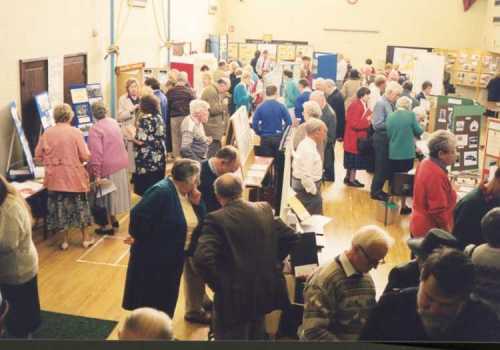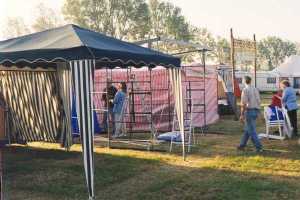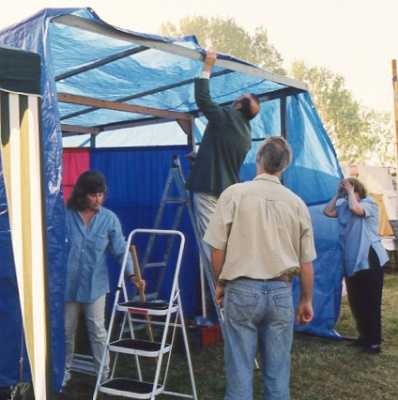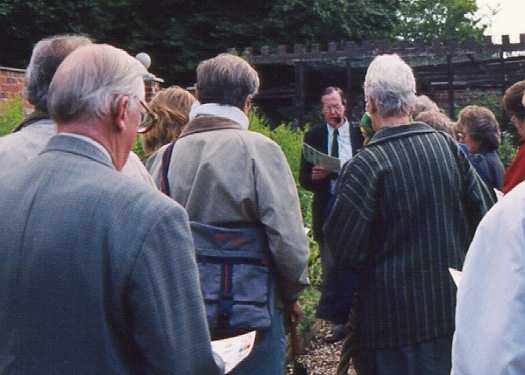 CIVIC TRUST BRIEFING - News from Whitehall
CIVIC TRUST BRIEFING - News from Whitehall
Don’t Choke Britain
The Local Government Association will be co-ordinating the Don’t Choke Britain campaign,
to be launched by Transport Minister Gavin Strang on 29th May. It aims to
promote practical solutions to traffic congestion and to raise awareness of the dangers
from traffic-related pollution. A Don’t Choke Britain action pack, with advice
on how to organise local initiatives, is available from the Local Government Association
(Tel. 0171 664 3346).
Slow down for safety
Introducing 20mph zones in order to create safer urban areas becomes easier under plans
announced by the government. Until now local authorities seeking to establish such zones
have had to follow a rigid procedure involving an application to the Secretary of State.
This has involved costs and delays. Now councils will have greater freedom.
Pedestrians should benefit from priority in residential urban areas under the scheme.
Initially areas near schools will be targeted, to be followed by others where there is
traffic congestion. A nationwide survey by the DETR found that pedestrian casualties had
been reduced by 61 % where 20mph zones had been introduced. Child cyclist casualties had
fallen by 67%.
Freight
A Civic Trust study A New Framework for Freight Transport suggested changes that
would lead to more area-based distribution of goods, shorter journey lengths, and a fall
in the total of heavy lorry traffic.
Long hauls have been substituted for shorter ones in recent years, with goods taking a
less direct route to the customer than they used to do. Heavy vehicles contribute
disproportionately to congestion and pollution. The Trust’s proposals for more
rational road freight management would cut environmental damage and also make it easier to
achieve a massive revival of rail freight.
Copies of the survey document are available from Saskia Hallam at the Civic Trust
(Tel. 0171 921 0180).
Opportunities for change
How can the broad aims of sustainable development be incorporated within the planning
system? This is one of the questions posed in the government’s consultation exercise
on the theme of how we can all make Britain greener.
It covers a wide range of issues. Some, such as transport and waste policy, are also
the subject of separate consultations One of the aims of the wider exercise is to put
these in context and explore sustainable development as a whole.
Local communities and councils are invited to submit practical examples of how such
policies have been Successfully implemented
There is a short consultation leaflet with a tear-off slip, which forms an excellent
popular introduction to sustainable development issues. Societies can order multiple
copies by contacting the Department of the Environment Transport and the Regions on a
local rate telephone number 0845 3000 815 quoting reference number 97EP0358
The full document Opportunities for change: a consultation paper on a revised UK
strategy for Sustainable developments, also from this number; quote reference number
97EP0277
Brownfield Development
The Deputy Prime Minister John Prescott says that ‘wherever possible recycled land
in urban areas should be built on first, provided it can be linked to public transport,
jobs, shops and other facilities’. This mirrors the sequential test introduced in
PPG6 for larger retail schemes, designed to boost town centres and curb the trend to
out-of-town developments.
Urban villages
One of the ways of maximising the use of brownfield land is more ‘urban
village’ projects, linking new housing with the creation of sustainable communities.
‘The government expects local planning authorities to adopt a more creative approach,
not only considering capacity but giving attention to the design of projects, to give
designers more scope for producing quality environments for urban living. The government
wants to herald a new era in community development for our towns and cities by bringing
the best of village life into the urban environment.’
The aim is for 60% of new houses to be built on recycled land over the next 1 0 years,
There will be regional variations for the brownfield targets, which will draw on local
knowledge of what is available.
The Civic Trust has played a leading role in advocating a tax on greenfield
development, with the proceeds earmarked for brownfield schemes that boost urban
regeneration. John Prescott says that this needs further debate and is a matter for the
Chancellor. Many believe that a fiscal measure of this sort is needed to back up new
planning guidance and create a more level playing field in the housing market.
The Civic Trust and others have suggested that thousands of brownfield sites are
currently dormant and that the true number is higher than that on which government
planning has been based. Some experts believe that enough brownfield land exists to
accommodate most of the new houses to be built up to 2016. These sites have been
overlooked partly because of the perception that it is currently cheaper to develop on
greenfield land.
A new pattern
It is widely accepted that the level of new housing requirement comes, not from a
higher population or immigration, but from demographic changes such as people living
longer, young people leaving home to set up on their own, or the breakdown of marriages.
(One commentator has pointed out that the official projections appear to assume that all
those who divorce or separate from partners will live alone for the rest of their lives!)
These factors suggest a pattern of housing provision that is different from the standard
suburban estate of 3 bedroom semi-detached houses with gardens. Given the right policy
framework they could help realise aspirations for higher density developments revitalising
run-down areas.
The Grand total
The debate about the grand total has yet to take off. The overall figure for the
nation’s new housing requirement between 1996 and 2016 remains for the time being 4.4
million, Discussion has centred on the proportion of brownfield development and few have
questioned the total.
As the National Council’s Factfile No. 2 suggests, the science behind the
calculations is far from precise. There is still confusion between housing
‘need’, ‘demand’ and the developers targets, all blurred by the
official concept of the requirement. Figures for previous periods have turned out to be
underestimates, but this of itself does not resolve the ambiguity that still surrounds the
key concepts.
According to the DETR Housebuilding Bulletin, total starts on house building were
172,800 last year. This year’s total is put at 190,000. Both figures fall short of
the 230,000 needed annually if the demand for 4.4 million houses by 2016 is to be met.
John Prescott has said ‘We don’t believe that the patterns of the past should
automatically set future housing provision. We believe changes in policy can and will make
a difference'.
What will the requirement be for the period after 2016? Will there be so many
brownfield sites left by then? In the longer term sustainability - the overriding
requirement -may mean more radical thinking about this issue, with the limits of
environmental capacity and peoples needs reconciled through a degree of demand management
that has so far not been considered.
Planning for the communities of the future (price £5.65) is available from the
Department of the Environment, Transport and the Regions (Tel 0171 873 0011).
Stress resistance
An estimated £60 million a year is spent on buying and planting amenity trees, and vet
many fail to survive after planting. Estimates vary from 50 per cent of standard
trees dying in urban areas to 39 per cent of all planted trees dying in their first five
years.
Poor handling during lifting and transplanting can cause damage to young trees, which
seriously impairs survival and performance. While it is commonly accepted that the best
time to plant trees is when they are dormant, new research from the Forestry Commission
shows that their resistance to stress varies during the dormant season.
SNIPPETS from The Ipswich Society
LOTS more to come
We live in an age of acronyms, most of them hard to remember and harder still to
understand. One of the simplest, however, is "LOTS" - Living Over the Shop. The
organisation promoting such accommodation is campaigning nationally for 500,000 homes to
be created from vacant premises over shops. Surely a welcome drive which would bring life
and customers into town centres and perhaps save more greenfield sites. Ipswich was one of
the first towns to take up the idea and we would have had substantially more such
accommodation if central Government hadn’t cut off the grants a few years ago.
Restored landmark might even smile one day
Wolsey’s Gate has been a diminishing asset for years. It used to be thought of as
one of the most precious landmarks of Ipswich. But there’s been little pleasure to go
and see it, isolated as it is by fast-moving heavy traffic and its brick and stone have
been worn down by pollution and vibration. However, restored discreetly last year with
grant aid from English Heritage, it’s in a much better state now.
LOCAL NOTICES
Hadleigh Deanery Fete and Novelty Dog Show
Bank Holiday Monday, 31st August at 2pm.
HADLEIGH SOCIETY NEWS
Bricks Through The Centuries
Roger Kennell gave an interesting illustrated talk to the Society members on The 28th
April. Bricks have a long history of use and remarkably, they are still today the basic
component for building work. Evidence of this can be seen with the current developments in
Station road, while at nearby Polstead Church in the nave arcades, there can be seen the
earliest English made bricks, which date from 1160. Little Wenham Hall also nearby has
late 13th. Century brickwork. Colchester, from an even earlier date, displays
copious examples of Roman made bricks, and some of these have been reused, often more than
once.
Colour slides illustrated the various uses and details of bricks through the centuries,
and some visible effects of the brick making process. For instance, those bricks which
before they had been burnt, had been used for tally marks, and which recorded in
thousands, the number of bricks made by the brick maker. Sometimes, later the bricklayer
would lay these bricks with the finger tip markings showing in the wall. Members were set
the task to try to find a brick which had ten marks showing, in Hadleigh, as to date,
numbers from one to nine had only been found, although there were examples elsewhere.
The audience was challenged to identify some typical brick bonds, but was spared the
complexities of the more unusual, such as St. Andrews Cross Bond and Chinese Bond. There
followed a light hearted conclusion with a series of slides showing different aspects of
brick, from The Brickmaker's Arms public house sign, a village bricklayers tomb stone, of
Robert Lock who died in 1873, and which showed his tools, to the builder's name board
outside a property which stated: A. Brick, the Builder!
Those present certainly would now be looking at the brickwork around them in a new
light, and would perhaps be alerted on some future occasion to protect the great
architectural building heritage which Hadleigh contains and avoid such horrendous repair
work as had been carried out in the High Street.
Next Meeting -
A Brett Valley Patchwork
Replacing our previously advertised programme, Sue Andrews will entertain us with some
historical titbits from along the length of the Brett Valley. Come and hear her at
Hadleigh Old Town Hall on Tuesday 11th August at 8pm.
Recent Activities
Suffolk Local History Council.
 Jan and Joe Byrne attended the Societies’ Day at Mendlesham.
Jan and Joe Byrne attended the Societies’ Day at Mendlesham.
Sue Andrews was one of the "15-minute" speakers in the morning. Over  the
lunch hour they set up a display about the Hadleigh Guildhall and Archive, then spent an
interesting afternoon talking to people about the work going on in Hadleigh.
the
lunch hour they set up a display about the Hadleigh Guildhall and Archive, then spent an
interesting afternoon talking to people about the work going on in Hadleigh.
May Show
This year we decided to have our own stand at the May show and a working party met
weekly through April and May whilst a stand grew in the Byrne’s garden and displays
were created for the inside.
 Four o’clock on the Friday afternoon saw the team erecting the
scaffolding based shell on the show ground, ready for an early start the next morning.
Four o’clock on the Friday afternoon saw the team erecting the
scaffolding based shell on the show ground, ready for an early start the next morning.
 Six in the morning and a fine start to the day as the display takes shape.
Six in the morning and a fine start to the day as the display takes shape.
All the effort was rewarded as a sunny day brought crowds to the show and many
interested visitors to our stand with several new members being signed up.

 Heraldic Garden
Heraldic Garden
Despite the bad weather over twenty members joined the evening visit to the Heraldic
Garden at Boxford. After an illustrated introduction to the origins and purposes of
heraldry by Sir Conrad Swan we were taken on a tour of the garden to see how plants have
often been used to introduce puns and humour into heraldry.
Planning Matters
Meet us at the Town Council offices if you want to look at the latest planning
proposals. We will be there at 12 noon on following dates: 5 Aug, 2 Sep.
Contact Jan Byrne, 01473 822192
1998/9 Programme
 All views expressed are those of the contributors and are not necessarily
those of the Hadleigh Society
All views expressed are those of the contributors and are not necessarily
those of the Hadleigh Society